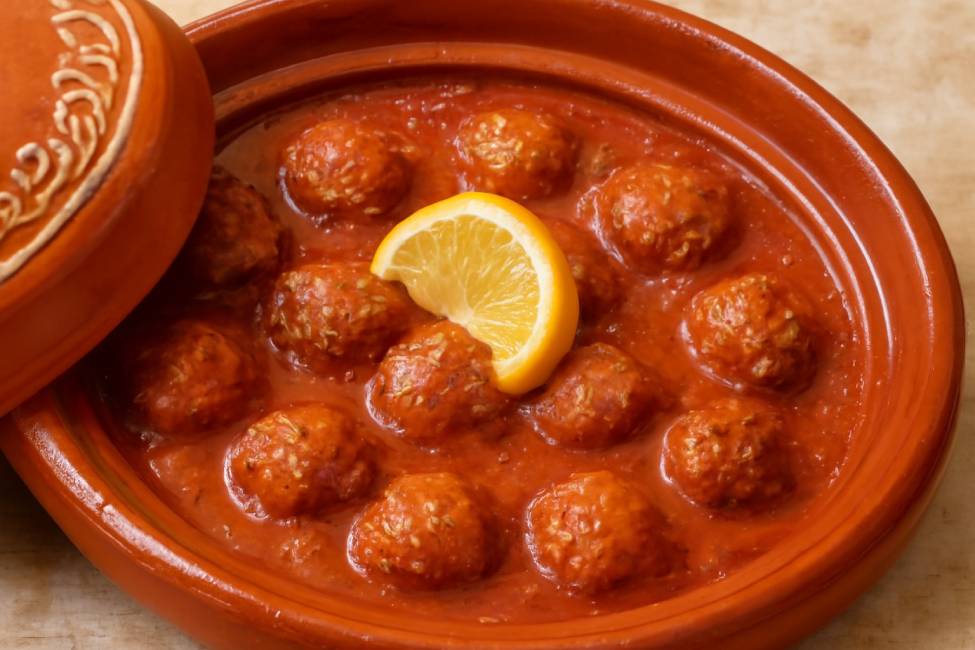Table of Contents
✨ Discover the Flavors of Morocco with a Zesty Twist
Moroccan cuisine is renowned for its bold flavors, aromatic spices, and the ability to transport your taste buds on a culinary journey through North Africa. At the heart of this vibrant cuisine lies a deep tradition of blending spices like cumin, coriander, and cinnamon, creating dishes as fragrant as they are delicious. Among these, Moroccan meatballs, known as kefta in local tradition, stand out as a true gem.
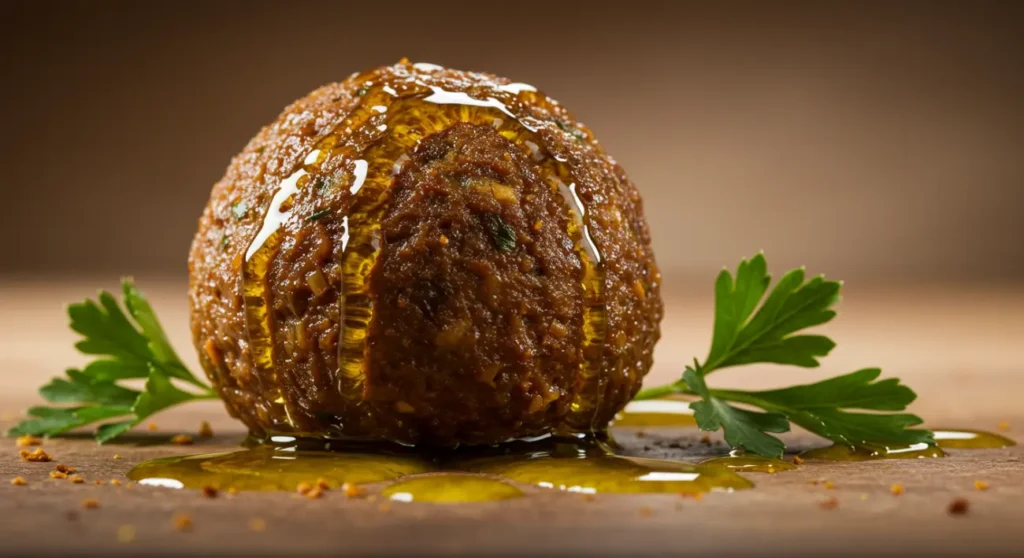
Moroccan meatballs combine the robust flavors of seasoned ground meat, often lamb or beef, with various spices and fresh herbs. These bite-sized morsels are not only satisfying but also incredibly versatile. Whether served over fluffy Moroccan couscous, paired with warm flatbread, or simmered in a spicy tomato-based harissa sauce, they offer endless possibilities for customization and enjoyment.
For a deeper understanding of Moroccan spices, check out this overview of Moroccan spice blends on Wikipedia.
In this blog post, we’ll take you through the steps to craft the perfect Moroccan meatballs. But there’s more: we’re adding a zesty twist to the classic recipe by incorporating ingredients like lemon zest and harissa to elevate the flavors further. Get ready to create a dish that’s not only bursting with bold spices but also brightened with a tangy, citrusy kick, perfect for impressing family and friends or simply treating yourself to an unforgettable meal. Let’s dive in!
🍽️ What Makes Moroccan Meatballs Special?
What makes Moroccan meatballs so unforgettable? The answer lies in their layers of bold spices, thoughtful preparation, and versatile serving methods that adapt beautifully to every occasion.
Moroccan meatballs are a beloved staple of North African cuisine, celebrated for their intense flavors and adaptability. What sets them apart from other meatball recipes worldwide is a harmonious combination of unique spices, the right choice of meat, and various ways they can be served.
🌿 Rich Flavors from Authentic Moroccan Spices
Moroccan meatballs are characterized by their generous use of traditional spices, which bring depth and complexity to every bite. Ras el Hanout, a signature Moroccan spice blend, is the star. Translating to “top of the shop,” this blend typically includes a medley of up to 30 spices, such as cinnamon, nutmeg, turmeric, and cardamom. Its warm and slightly sweet profile results from the generous use of these spices.
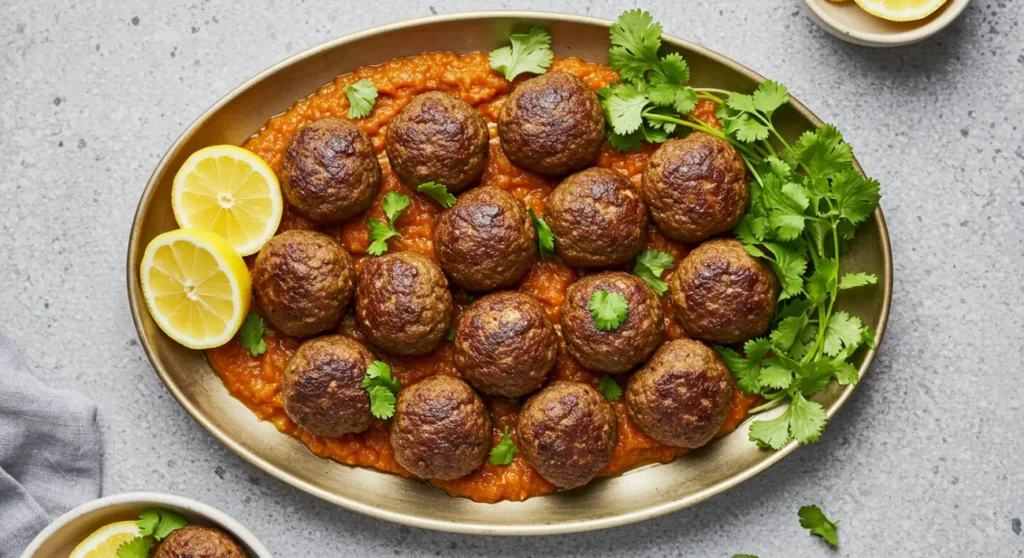
In addition to Ras el Hanout, spices like cumin and coriander add an earthy, nutty undertone, while paprika hints at smokiness. For those who crave heat, harissa, a spicy chili paste, is often incorporated, lending a fiery kick to the meatballs or the accompanying sauce. This symphony of spices ensures that Moroccan meatballs are anything but ordinary.
Want to learn more about the impact of spices on health and flavor? Visit this article on cumin’s benefits from Healthline.
🥩 A Perfect Blend of Meat Choices
Another element that makes Moroccan meatballs truly special is the thoughtful selection of meat. Traditional recipes often call for ground lamb, prized for its rich, slightly gamey flavor that pairs beautifully with the spices. Ground beef is an excellent alternative for those who prefer a milder taste, or you can use a combination of both types of meat for a balanced flavor and texture.
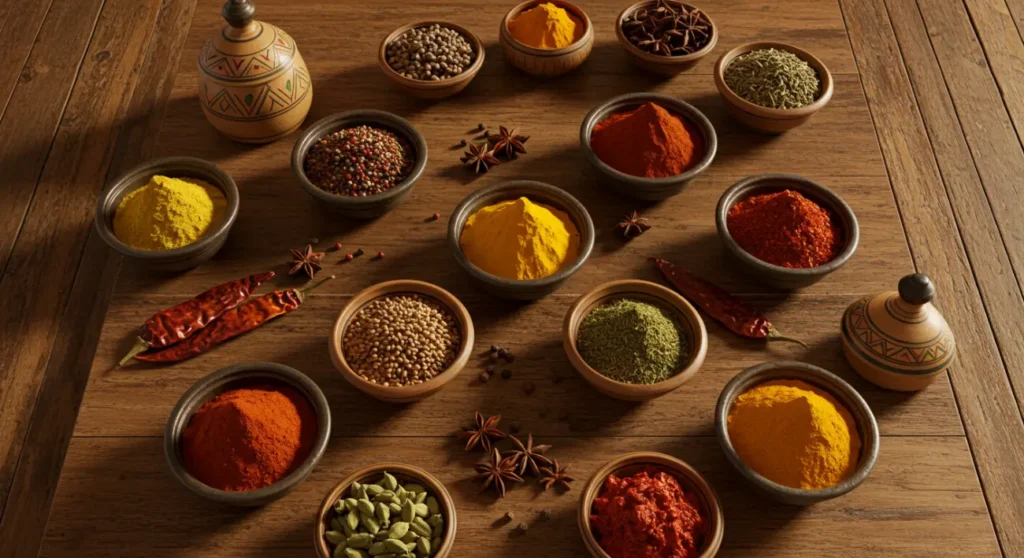
The key to achieving the perfect Moroccan meatball is maintaining the proper fat ratio to lean meat. A little fat ensures the meatballs remain moist and tender, while the spices and fresh herbs bind the mixture together, creating a melt-in-your-mouth consistency that’s truly irresistible.
🍞 Accompaniment and Side Dishes
One of the many reasons Moroccan meatballs are so beloved is their versatility in presentation. They can be served in various ways, making them suitable for casual family dinners or elaborate feasts. A few popular accompaniments include:
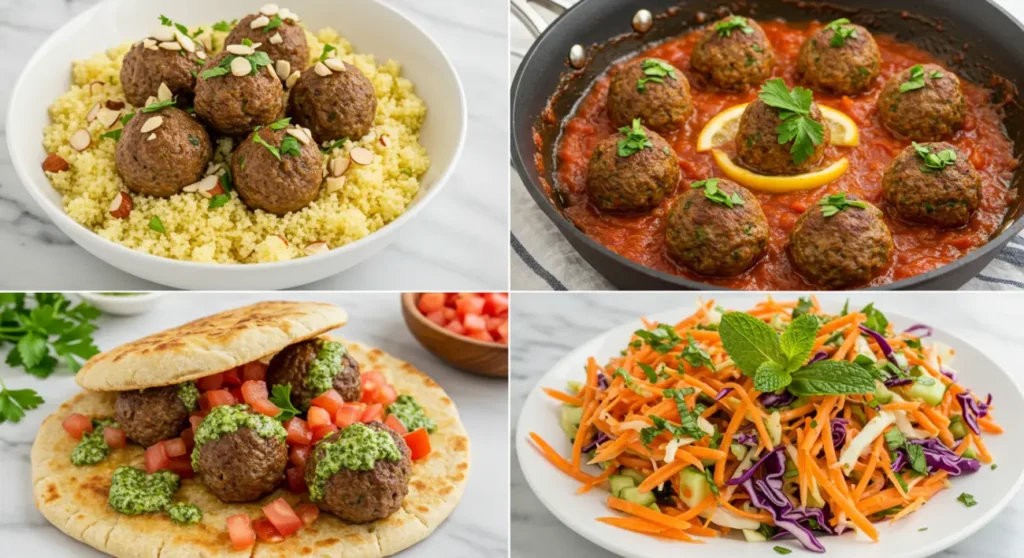
- Couscous: Fluffy and light, this traditional North African dish is the perfect base for the flavorful sauces of Moroccan meatballs.
- Flatbread: Warm and soft, Moroccan flatbread or pita is ideal for scooping up the meatballs and sauce.
- Refreshing Salads: Pair the rich and spiced meatballs with a fresh cucumber and tomato salad, lightly dressed with lemon juice and olive oil, to balance the flavors.
- Tagine Presentation: For an authentic touch, serve the meatballs in a traditional tagine, a clay pot that enhances the dish’s aroma and visual appeal.
Looking for another Moroccan dish that pairs beautifully with fresh vegetables and sauce? Try our Fish Tagine with Artichokes and Peas.
Moroccan meatballs are not just a meal; they’re an experience that combines vibrant flavors, satisfying textures, and a world of pairing possibilities. The following section will explore the ingredients needed to craft your perfect Moroccan meatballs with a zesty twist!
🍋 Essential Ingredients for Perfect Moroccan Meatballs
To unlock the bold and balanced flavors of Moroccan meatballs, three essential elements work together: spices, meat, and a zesty surprise. Let’s look at how these come together in perfect harmony.
Creating the perfect Moroccan meatballs requires the right combination of fresh ingredients, aromatic spices, and creativity. These key elements combine to form a dish rich in flavor, tender in texture, and truly unforgettable. Let’s explore the essential ingredients to make your Moroccan meatballs stand out, including a zesty twist that takes the classic recipe to new heights.
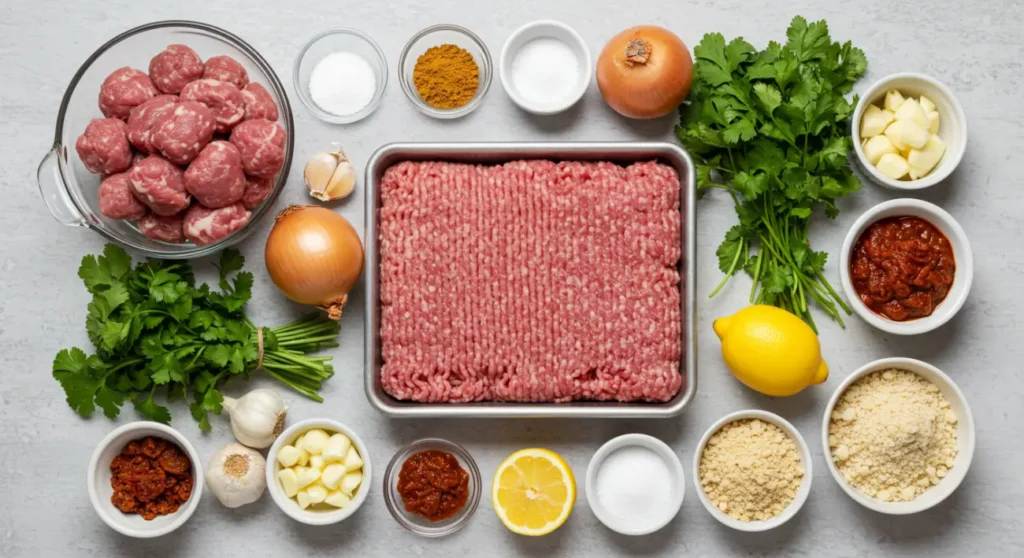
🧂 Key Spices and Herbs
The foundation of Moroccan meatballs lies in their signature blend of spices and herbs, which create a distinctive, bold flavor profile. Some of the key spices and herbs include:
- Ras el Hanout: This quintessential Moroccan spice blend is a cornerstone of the dish. With its warm, aromatic mix of cinnamon, cardamom, nutmeg, and other spices, Ras el Hanout adds a depth of flavor that makes these meatballs unique.
- Cumin and Coriander: These earthy spices provide a subtle nuttiness and unmistakable warmth that balance the sweetness of the other ingredients.
- Paprika: Whether sweet or smoked, paprika adds vibrant color and subtle smokiness to the meatballs.
- Fresh Parsley and Cilantro: These herbs bring brightness and a hint of freshness to the rich, spiced meat mixture. Chopping them finely ensures an even distribution of flavor.
The careful balance of these spices and herbs ensures that every bite of the meatballs is layered with complexity and richness.
Explore more about the unique role of harissa in North African cuisine in this article from Serious Eats.
🥩 Meat Selection
The choice of meat is equally vital in crafting perfect Moroccan meatballs. Traditional recipes often feature ground lamb, prized for its bold flavor that beautifully complements the spices. However, ground beef is a popular and widely available alternative. For a balanced approach, many cooks combine lamb and beef, achieving a flavorful yet not overly rich mixture.
The fat content of the meat is the key to tender, juicy meatballs. A higher fat percentage (around 15-20%) ensures the meatballs remain moist during cooking. Adding olive oil or grated onions can help achieve the desired texture when working with lean meat.
Looking for another Moroccan dish using rich meat and spices? Don’t miss our Stuffed Leg of Lamb recipe.
🌶️ The Zesty Twist
While traditional Moroccan meatballs are packed with flavor, adding a zesty twist can elevate them to new heights. Two standout ingredients bring this additional layer of brightness and complexity:
- Lemon Zest: Grating fresh lemon zest into the meatball mixture adds a subtle, citrusy tang that complements the meat’s richness and spices. It also infuses the dish with a fresh aroma, making the flavors pop even more.
- Harissa Paste: For those who love a touch of heat, harissa paste is the perfect addition. This fiery North African chili paste is made with roasted peppers, garlic, and spices. It provides a smoky, spicy kick that enhances the meatballs and the accompanying sauce.
These zesty additions brighten the dish and create a dynamic interplay of flavors that will leave a lasting impression on your taste buds.
With these essential ingredients, you’ll be well on your way to crafting Moroccan meatballs bursting with flavor, perfectly tender, and uniquely zesty. Next, we’ll guide you through the step-by-step process of combining all these elements into a show-stopping dish. Let’s get cooking!
🥄 Step-by-Step Recipe for Moroccan Meatballs
Crafting the perfect Moroccan meatballs is a journey of combining bold flavors, tender textures, and vibrant sauces. This step-by-step guide will walk you through the process, ensuring your dish is authentic and enhanced with a zesty twist.
🍖 Preparing the Meatball Mixture
The foundation of delicious Moroccan meatballs starts with the right mixture of ingredients. Here’s how to prepare it:
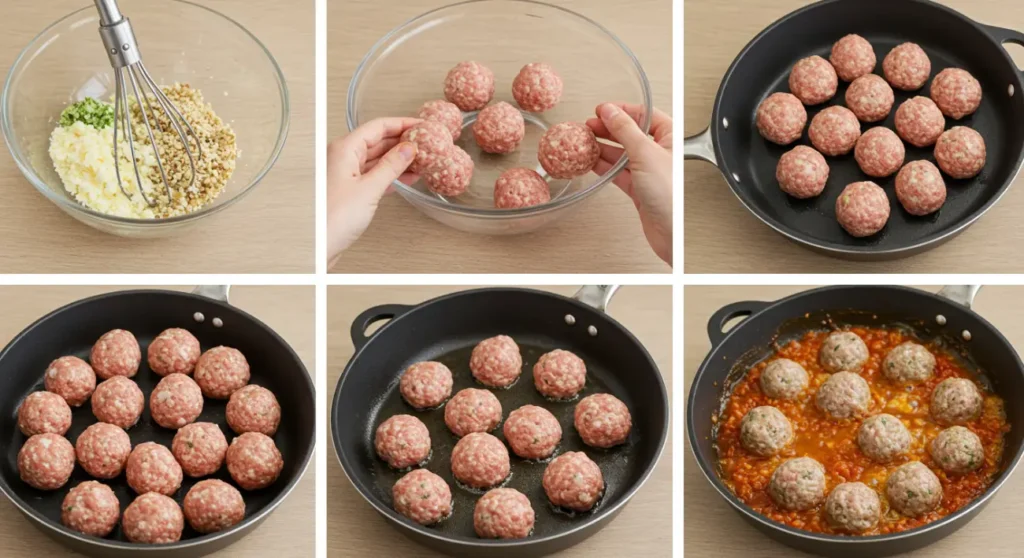
- Choose Your Meat: Begin with 1 lb of ground lamb, beef, or a combination of both. The meat should have a good fat content (15-20%) to keep the meatballs moist and flavorful.
- To incorporate Aromas, finely chop half an onion and mince two to three garlic cloves. These add moisture and a savory depth to the meat mixture.
- Incorporate Spices and Herbs: Add 2 teaspoons of Ras el Hanout, 1 teaspoon of cumin, 1 teaspoon of coriander, 1 teaspoon of paprika, and a pinch of chili flakes (optional for extra heat). Finely chop fresh parsley and cilantro and fold in about 2 tablespoons of each.
- The Zesty Twist: Grate the zest of one lemon and mix it for a bright, citrusy aroma that balances the richness of the spices and meat.
- Bind the Mixture: Add 1/3 cup of breadcrumbs and 1 egg to bind the ingredients together—season generously with salt and pepper.
- Shape the Meatballs: Using your hands or a small scoop, shape the mixture into uniform balls, about 1-1.5 inches in diameter. Arrange them on a platter or a baking tray.

🍳 Cooking the Meatballs
You can cook the meatballs using either of these two methods, depending on your preference:
- Pan-Frying:
- Warm 2 to 3 tablespoons of olive oil in a large frying pan over medium heat
- Introduce the meatballs in portions, taking care not to overcrowd the skillet.
- Sauté for 6 to 8 minutes, rotating periodically, until they are evenly browned and fully cooked.
- Baking:
- Preheat the Oven: Set your oven to 400°F (200°C) and allow it to warm up
- Place the meatballs on a parchment-lined baking sheet and lightly brush them with olive oil.
- Bake the Meatballs: Place them in the oven for 18 to 20 minutes, turning them halfway through to ensure even browning.
🍅 Making the Zesty Tomato Sauce
The sauce ties the entire dish together, enhancing the flavors of the meatballs. Here’s how to make it:
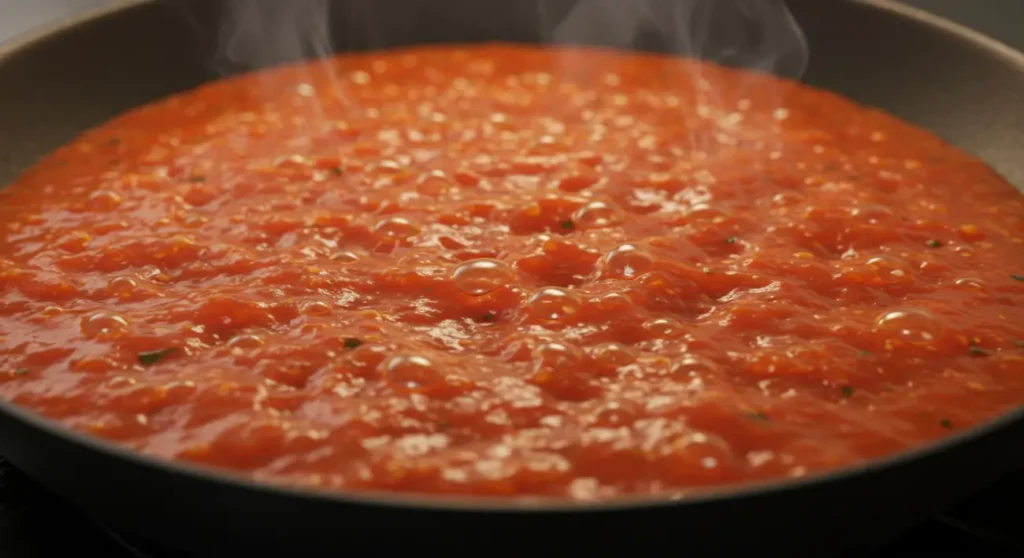
- Start with the Base:
- In a sizable skillet or saucepan, heat 2 tablespoons of olive oil.
- Sauté a finely chopped onion and 2 minced garlic cloves until soft and fragrant.
- Add Harissa and Spices:
- Stir in 2 tablespoons of harissa paste for a smoky, spicy base. Add 1 teaspoon of cumin and a pinch of paprika for added depth.
- Incorporate Tomatoes:
- Pour in a 14-ounce can of crushed tomatoes and 1/2 cup of water or chicken stock. Combine thoroughly and bring to a gentle boil.
- Simmer for Flavor:
- Adjust the sauce’s seasoning with salt, pepper, and a teaspoon of sugar to counteract the acidity.
- Allow it to simmer for 10 to 15 minutes so that the flavors can blend harmoniously.
🥗 Bringing It All Together
Now it’s time to combine the meatballs and sauce into one cohesive dish:
- Add the Meatballs to the Sauce:
- Gently place the cooked meatballs into the simmering tomato sauce. Turn them carefully to coat them evenly.
- Simmer for Flavor Infusion:
- Cover the skillet and let the meatballs simmer in the sauce for 10 minutes. This allows the spices and herbs from the meatballs to enhance the sauce, creating a harmonious blend.
- Finish with a Zesty Touch:
- Sprinkle chopped parsley and cilantro over the dish just before serving. Squeeze a bit of fresh lemon juice on top for an extra zing.
Looking for another hearty dish with rich sauce and vegetables? Try our Beef Tagine with Artichokes & Fava Beans.
The tender meatballs are infused with bold flavors, and the sauce is perfectly spiced with a zesty twist. Your Moroccan meatballs are ready to serve. Pair them with couscous, flatbread, or a refreshing salad for a meal that’s as visually stunning as delicious.
🧑🍳 Tips and Tricks for Perfect Moroccan Meatballs
Even the most flavorful recipe needs the right techniques. Here’s how to make sure your Moroccan meatballs come out tender, balanced, and irresistibly good every single time.
Perfecting Moroccan meatballs is as much about technique as the ingredients. To ensure your dish turns out flawless, here are some practical tips and tricks covering texture, spice adjustments, cooking methods, and presentation.
🔸 Achieving the Ideal Texture
The texture of Moroccan meatballs should be tender and succulent, not dense or dry. Achieving perfection: Follow these steps to ensure optimal results:
- Balance Breadcrumbs and Meat:
- Breadcrumbs act as a binder and help keep the meatballs moist by absorbing and retaining the juices as they cook. For a soft, cohesive texture, use about 1/3 cup of breadcrumbs for every pound of meat. Too many breadcrumbs can make the meatballs fall apart, so keep the balance in check.
- Add Moisture with Onions and Herbs:
- Finely grated onions and freshly chopped herbs enhance the flavour and introduce moisture into the mixture, ensuring every bite is juicy.
- Don’t Overmix the Ingredients:
- Combine Ingredients: Gently blend the meatball components until they are just mixed.
- . Overworking the mixture can lead to a more rigid texture.
🥵 Adjusting the Spice Levels
The beauty of Moroccan meatballs lies in their bold, layered flavors, but you can easily customize the spice level to suit your palate:
- For Mild Heat:
- Use a hint of harissa paste or substitute sweet paprika for a smoky but mild flavour profile.
- For Medium Heat:
- To add gentle warmth without overpowering the dish, include a teaspoon of harissa and a pinch of chili flakes in the sauce or meat mixture.
- For Maximum Spice:
- Add a tablespoon of harissa to the sauce for a fiery kick, and sprinkle in some cayenne pepper or hot chili powder. For a spicy garnish, drizzle extra harissa on top before serving.
🍳 Cooking Techniques
The method of cooking Moroccan meatballs can affect their flavor and texture. Overview of Techniques: Here’s a summary of the most prevalent methods:
- Tagine Cooking:
- A tagine is a traditional clay cooking vessel that creates a unique, slow-cooked flavor. The lid traps steam, keeping the meatballs tender while infusing them with the aromatic spices of the sauce. This method is ideal for those seeking an authentic Moroccan experience.
To explore more on this method, check out this guide on tagine cooking from The Spruce Eats.
- Skillet Cooking:
- Pan-frying is a quick and convenient way to brown the meatballs, creating a delicious crust that locks in their juices. This method works well for busy weeknights when time is limited.
- Baking in the Oven:
- Baking is an even, hands-off cooking method perfect for making larger batches. It’s also a healthier option, requiring less oil than pan-frying.
. Optimal Cooking Method:
- Consider searing the meatballs in a skillet and then cooking them in the sauce on the stovetop or in a tagine for superior results. This approach combines the benefits of both methods, delivering a rich, flavorful dish.
Want to try another classic tagine recipe? Discover our Lamb Tagine with Sweet Onions.
🍽️ Serving Suggestions
Presentation is key to transforming a simple dish into a feast for the senses. Here are a few ways to serve Moroccan meatballs:
- With Couscous:
- Fluffy, steamed couscous is a classic pairing. It soaks up the rich tomato sauce and complements the spiced meatballs. For extra flavor, toss the couscous with olive oil, lemon zest, and fresh herbs before serving.
- With Flatbread:
- Serve the meatballs with warm Moroccan flatbread or pita, perfect for scooping up the sauce. This option is ideal for a casual, family-style meal.
- As an Appetizer:
- Arrange the meatballs on a platter with small bowls of harissa, yoghurt-based dipping sauce, or tahini for dipping. Garnish with chopped parsley for an elegant touch.
- With a Salad:
- Pair the rich, spiced meatballs with a light, refreshing salad of cucumbers, tomatoes, red onions, olive oil, and lemon juice. The salad’s bright acidity balances the meatballs’ bold flavors.
- Over Rice or Grains:
- If you don’t prefer couscous, serve the meatballs over basmati rice, quinoa, or even orzo for a hearty and satisfying meal.
Following these tips and tricks will elevate your Moroccan meatballs to restaurant-quality perfection. Whether you’re serving them for a quick family dinner or an elaborate feast, these techniques and ideas will ensure that your dish is unforgettable.

❓ Frequently Asked Questions About Moroccan Meatballs
Moroccan meatballs are a delightful dish that many home cooks are eager to try, but questions often arise about preparation, substitutions, dietary adjustments, and pairing options. Here, we address some common questions to help you master this flavorful recipe.
🕒 Can I Make Moroccan Meatballs Ahead of Time?
Absolutely! Moroccan meatballs are a fantastic make-ahead dish, and here’s how you can manage preparation and storage effectively:
- Preparing in Advance:
- Advance Preparation: You can assemble the meatball mixture a day in advance. Form the meatballs, place them on a baking sheet, cover with plastic wrap, and refrigerate until ready to cook.
- Storing Cooked Meatballs:
- Once cooked, allow the meatballs to cool completely before storing them in an airtight container in the refrigerator.
- Refrigeration: Store them in the refrigerator, remaining fresh for 3 to 4 days.
- Reheating Tips:
- To reheat, place the meatballs in a saucepan with a little sauce and heat gently over low-medium heat until warmed through. Alternatively, warm them in the oven at 350°F (175°C) for 10 to 15 minutes.
- Freezing for Later:
- Moroccan meatballs freeze beautifully. Lay them on a baking sheet in a single layer, freeze until solid, and then transfer to a freezer-safe container or bag. You can freeze them for a maximum of three months. Reheat them from frozen by simmering them directly in sauce or baking them in the oven.
🌶️ What’s the Best Substitute for Ras el Hanout?
If Ras el Hanout is unavailable, don’t worry! You can create a similar flavor profile using common spices you may already have:
- DIY Ras el Hanout:
- Mix equal parts cumin, coriander, cinnamon, paprika, turmeric, and ginger. Include a pinch of cayenne pepper or chili powder to introduce some spiciness.
- Other Spice Blends:
- Garam masala or curry powder can work as substitutes, although they may slightly alter the dish’s flavor. Adjust by adding a bit of cinnamon or nutmeg to bring it closer to a Moroccan profile.
- Experiment with Single Spices:
- If you don’t have a blend, use a combination of cumin, coriander, and cinnamon as a base. These are the most essential spices in Moroccan meatballs.
🌾 Are Moroccan Meatballs Gluten-Free?
Traditional recipes often include breadcrumbs as a binder, which contain gluten, but you can easily adjust the recipe to make it gluten-free:
- Gluten-Free Breadcrumbs:
- Replace standard breadcrumbs with gluten-free breadcrumbs or crushed gluten-free crackers.
- Alternative Binders:
- Use almond flour, ground oats, or cooked and mashed potatoes as gluten-free alternatives.
- Sauce Adjustments:
- Check the labels to ensure that the harissa paste and any canned tomatoes or stock you use are gluten-free.
By making these small changes, you can create a dish safe for those with gluten sensitivities while retaining the authentic flavor and texture.
🍷 How Do I Pair Moroccan Meatballs with Drinks?
Pairing Moroccan meatballs with the right beverage can elevate your dining experience. Based on your preferences, here are some tailored suggestions:
- Traditional Moroccan Tea:
- Serve with hot mint tea, which is lightly sweetened and aromatic, making it an excellent complement to the spices in the dish.
- Wine Pairings:
- Red Wine: Choose a medium-bodied red wine like Grenache or Syrah. These fruity and spicy notes complement Moroccan meatballs’ rich, spiced flavors.
- White Wine: A crisp Sauvignon Blanc or a dry Riesling can balance the bold spices with their acidity for a lighter pairing.
- Non-Alcoholic Options:
- A chilled glass of sparkling water with lemon is refreshing and cleanses the palate between bites.
- For a sweet and fragrant complement, try a spiced Moroccan lemonade (lemon juice, sugar, water, and a hint of orange blossom water).
- Cocktails:
- A citrus-forward cocktail like a lemon or orange gin fizz pairs beautifully with the zesty flavors of the dish.
Addressing these common questions will give you the confidence to prepare, customize, and serve Moroccan meatballs according to your taste and lifestyle. Do you have more questions? Feel free to ask or experiment with your creative touches!
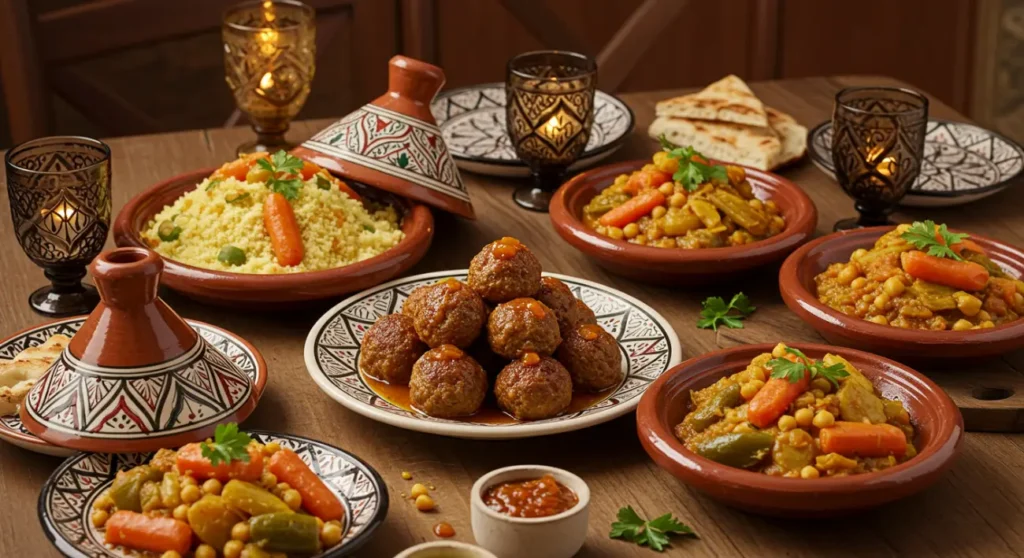
🍽️ Conclusion
Moroccan meatballs are a culinary masterpiece that combines simplicity with vibrant, bold flavors. From the aromatic blend of spices like Ras el Hanout and cumin to the zesty touch of lemon and harissa, this recipe captures the essence of Moroccan cuisine in every bite. Whether you’re cooking for a family dinner, entertaining guests, or simply exploring new flavors in your kitchen, these meatballs offer a versatile and unforgettable dish that’s surprisingly easy to prepare.
We hope this recipe inspires you to dive into the rich traditions of Moroccan cooking and try your hand at crafting these flavorful meatballs. They’re satisfying to make and a joy to serve, paired with couscous, flatbread, or a refreshing salad. Don’t hesitate to adjust the spices, experiment with the accompaniments, or add your touch to make this recipe uniquely yours.
If you’ve enjoyed learning about Moroccan meatballs, we’d love to hear from you! Try the recipe, share your experiences, and tell us how it turned out. Did you add your twist? What side dishes or drinks did you pair with it? Leave a comment or share your creations on social media—we’d be thrilled to see your take on this classic dish!
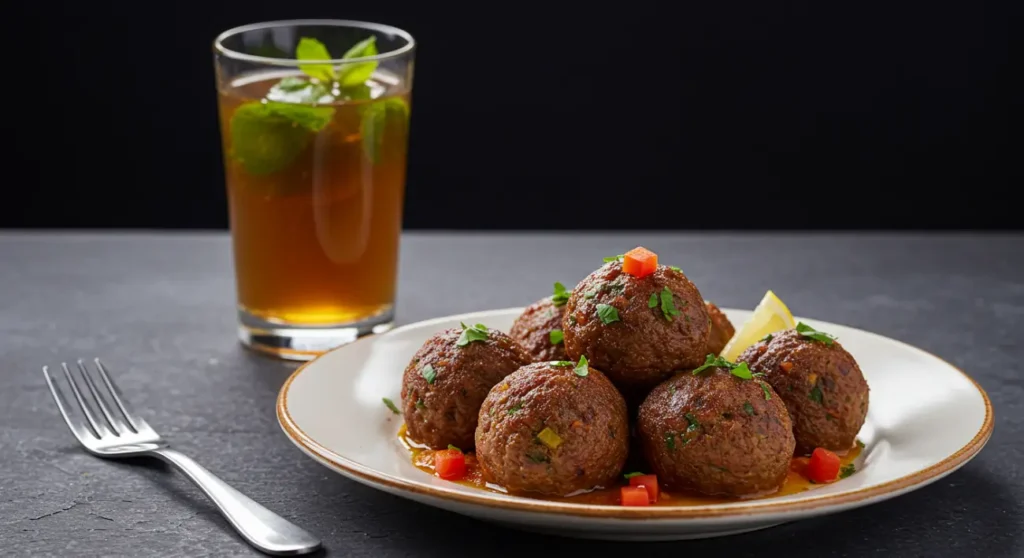
Ready for more culinary adventures? Explore our curated selection of Moroccan-inspired recipes, including traditional tagines, spiced couscous salads, and more. One great place to start is our comforting Vegetable Tagine, a vegetarian delight full of warm flavors.
Happy cooking, and bon appétit!
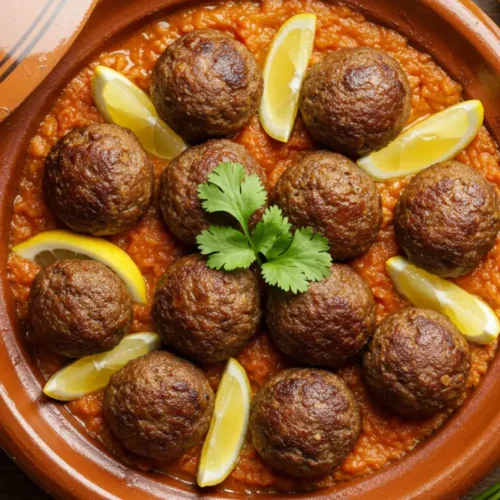
How to Make Perfect Moroccan Meatballs with a Zesty Twist
Equipment
- 1 Large Mixing Bowl –
- 1 Small Ice Cream Scoop or Meatball Spoon (optional)
- Kitchen Gloves (Optional)
- Non-Stick Skillet or Cast Iron Pan
- Deep Sauté Pan or Dutch Oven
- Chef's Knife and Cutting Board
- Garlic Press
- Wooden Spoon or Silicone Spatula
- Tagine (Optional)
- Serving Platter or Bowl
Ingredients
For the Meatballs:
- 500 g ground beef or lamb
- 1 small onion, finely chopped
- 2 cloves garlic, minced
- 2 tbsp chopped parsley
- 2 tbsp chopped cilantro
- 1 tsp ground cumin
- 1 tsp paprika
- 1/2 tsp ground cinnamon
- 1/2 tsp ground coriander
- 1/2 tsp salt (or to taste)
- 1/2 tsp black pepper
For the Sauce:
- 1 tbsp olive oil
- 1 small onion, finely chopped
- 2 cloves garlic, minced
- 400 g canned diced tomatoes
- 1 tbsp tomato paste
- 1 tsp ground cumin
- 1 tsp paprika
- 1/2 tsp cayenne pepper (optional, for heat)
- 1/2 tsp sugar (optional, to balance acidity)
- 1/2 cup water or broth
- Juice of ½ lemon
Instructions
For the Meatballs:
- In a large bowl, combine all the meatball ingredients and mix until well combined.
- Shape the mixture into small meatballs, about the size of a walnut. Set aside.
For the Sauce:
- Heat olive oil in a large skillet over medium heat. Add the onion and garlic, sautéing until soft and fragrant.
- Stir in the diced tomatoes, tomato paste, cumin, paprika, cayenne pepper (if using), sugar, and water/broth. Bring to a simmer.
- Add the meatballs to the sauce, ensuring they're submerged. Cover and cook for 15-20 minutes, turning the meatballs occasionally.
- Finish with a squeeze of lemon juice and garnish with fresh parsley or cilantro before serving.
Notes
- Serve with warm crusty bread, couscous, or rice.
- Adjust the spice levels by adding more cayenne pepper for heat or omitting it for a milder flavor.
- Leftovers can be stored in the fridge for up to 3 days or frozen for longer storage.
🍽️ Nutrition Information (Per Serving)
| Nutrient | Amount |
|---|---|
| Calories | ~320 kcal |
| Protein | 22g |
| Carbohydrates | 12g |
| Fat | 20g |
| Fiber | 3g |
| Sugar | 5g |
Join me on social media for more delicious recipes, tips, and inspiration!
💌 Want more recipes like this?
If you enjoyed discovering the secrets of Moroccan meatballs, don’t miss our upcoming recipes straight from North Africa’s vibrant kitchens. From tagines to couscous, every dish tells a story. Subscribe to our newsletter to receive weekly inspiration, cooking tips, and authentic Moroccan flavors delivered right to your inbox.
👉 Let’s keep cooking together!
📩 Join Our Moroccan Foodie Community
Get the best Moroccan tagine recipes and seasonal culinary tips straight to your inbox.
Clarifying Essential Terms and Ingredients
To help you better understand the ingredients and elements mentioned in this article, here are brief explanations of key terms commonly used in Moroccan cuisine:
Ras el Hanout
A hallmark of Moroccan spice blends, “Ras el Hanout” translates to “head of the shop,” representing the finest spices a merchant can offer. This versatile blend typically includes a mix of warming spices such as cinnamon, cumin, turmeric, and ginger, and is used to flavor iconic dishes like tagines and couscous.
💬 We’d love to hear from you!
Have you tried this Moroccan meatballs recipe? Did you add your own twist or serve it with a special side? Share your thoughts, tips, or questions in the comments below — your feedback helps others and inspires us to keep creating more flavorful recipes for you!
